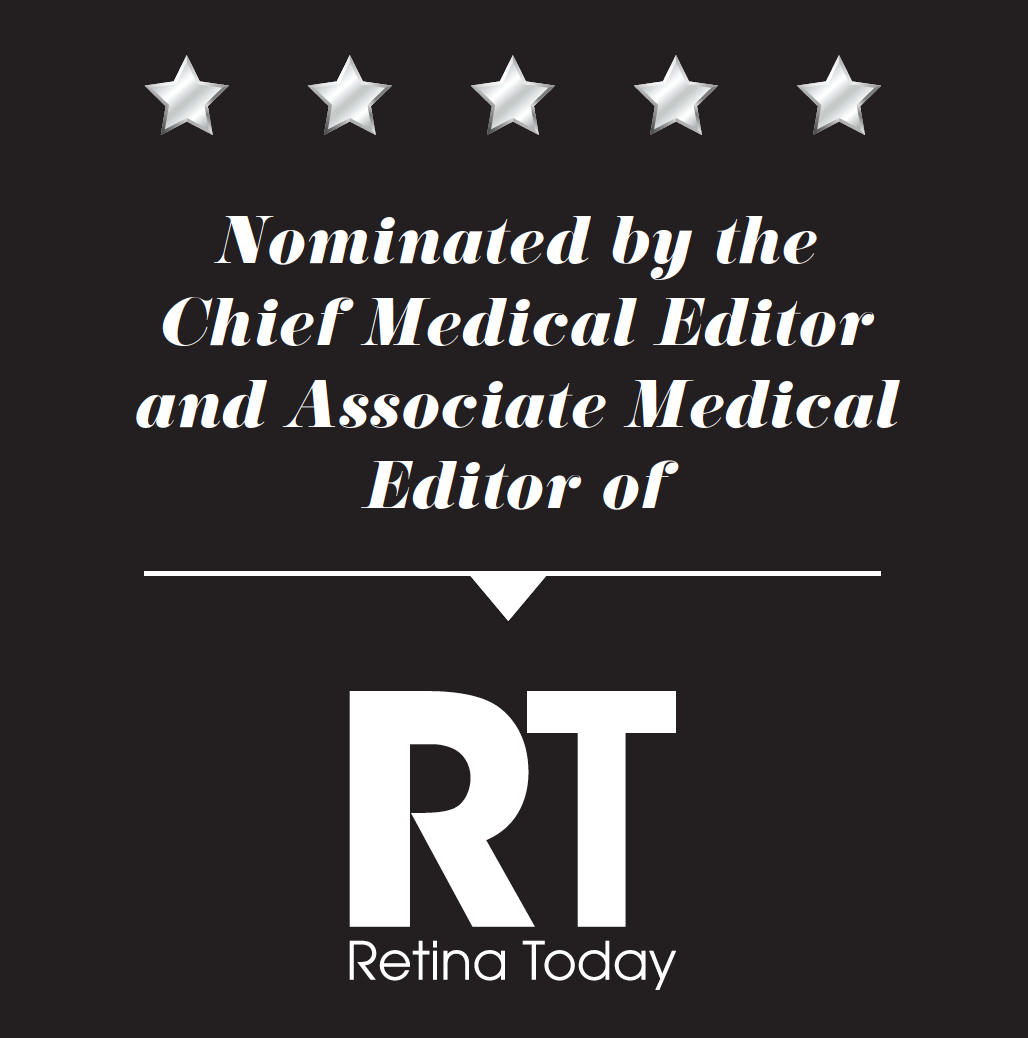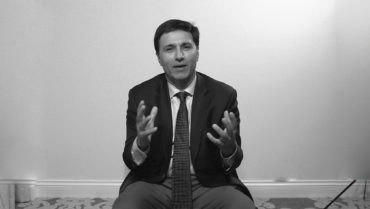Dr. Humayun, a Professor of Ophthalmology and Director of the University of Southern California Roski Eye Institute in Los Angeles, is the only ophthalmologist ever to be elected a member of both the US National Academies of Medicine and Engineering. In this interview, he explains how his grandmother inspired him professionally, and he describes his experience being contacted by the government about winning a prestigious presidential award.
Interviewed by Karen Roman, Retina Today Editor-in-Chief

BMC: Who or what drew you to ophthalmology?
Mark S. Humayun, MD, PhD: I was initially interested in neuroscience and becoming a neurosurgeon, but during medical school my grandmother lost her sight as a complication of diabetes. I remember taking her to all the top retina facilities, but at that time we still hadn’t figured out the role of laser in diabetes, and nobody really knew what to do. Her blindness redirected my focus to ophthalmology, retina in particular, and to developing therapies to prevent vision loss or to restore vision in those with sight-robbing ophthalmic conditions. Even now, when I see a patient who is on the verge of losing his or her vision or struggling with vision loss, it reminds me of why I got into this field.
BMC: What fueled your interest in innovating and inventing?
Humayun: I have always enjoyed coming up with new ideas and developing them into something bigger and better with the help of others. I knew I didn’t want to do the same thing over and over again—I wanted to be engaged in doing something novel, something that hadn’t yet been figured out. I like trying to address the unknown. I was interested in figuring out the puzzle of the brain and how that works and also the difficulties and the challenges that we are facing with the eye.
I remember saving up all my money to get a telescope and staying up late into the night, trying to see the moon, trying to see the planets. Jupiter, we could see at times of the year, Venus is really bright and you can see that relatively easily. It was something that I loved thinking about. I liked quantum physics—for example, the whole aspect of gravitational fields on space and time.
I audited some quantum physics courses during my PhD in biomedical engineering because I liked it so much. The thing that was lacking in it was that it was very abstract; I wanted to be involved in a more applied field. And then of course, my grandmother’s blindness really made me focus on trying to solve puzzles and things that can be translated and applied to patient care.
BMC: You have a Wikipedia page devoted to you. How do you feel about that?
Humayun: I check it periodically to make sure it’s factually correct. It’s gratifying, to some extent, that somebody thought it was worthwhile to add a Wikipedia page about me. What helps is, when I’m giving a talk, the moderator can go to the Wikipedia page and read it and then use those comments in my introduction. So it has some value, and I think it’s fairly accurate.
BMC: You were a co-inventor of the Argus II Retinal Prosthesis System (Second Sight Medical Products), which has been implanted in more than 300 patients worldwide. Did you expect it to reach this level of success?
Humayun: I didn’t expect this level of success, but I hoped for it, and it’s great to see how well certain patients do with the implant. The thought of restoring eyesight with an electronic implant was science fiction. If you were to tell someone that you were going to implant a chip in his or her eye so that he or she could see again after being blind for decades, that person would tell you that you are dreaming. Turning this dream into reality has been worth it all.
Although, and perhaps naively, I never doubted that it would work, in the back of my mind I always wondered how well it would work. That’s something you just can’t tell from preclinical testing. You can test as much as you want on a desktop and in preclinical models, but you will never know what level of vision you will get. That’s the difficult part. The level of vision some patients get with the Argus II amazes me.
The next area of development for the Argus II won’t be only in the hardware implant, but also in the software. In fact, I would like to develop software that provides color perception, helps with digital zoom, and maybe even helps with region of interest. (Think about the yellow box on an iPhone camera when it recognizes a face.) Region of interest can be useful in digital signal processing. Augmented reality could be an interesting area to explore. But taking advantage of the camera, the digital input, and the software and coding is where near-term advances will come.
BMC: What was it like to receive the National Medal of Technology and Innovation from President Barack Obama in 2016?
Humayun: It was amazing. The person who initially contacted me about it was from some government agency—maybe the CIA or the FBI, I don’t remember. But he didn’t come right out and tell me that I won anything. I thought it was hoax, but then I was given a number to call the White House, and it seemed official. I still had no idea what was going on. I was asked if I was available on a specific date, and I was finally notified that I had won the National Presidential Medal of Technology and Innovation. I was completely astonished. I mean, this medal had been previously given to Bill Gates, Steve Jobs, and Charles D. Kelman, MD. My mind was spinning. How did my name come up? Who nominated me? Did I even deserve it?
It was a great trip, a great ceremony, and it was an honor to meet President Obama and to accept the medal. He is smart: In a short period of time he understood the concept of the Argus. I had the medal in my hand and I still almost didn’t believe it was happening.
Since then, I have received a surprising amount of recognition and phone calls from people wanting to know about the award. It’s really amazing to be one of the select few who have received that award.
BMC: Would you say that receiving the National Medal of Technology and Innovation has been your greatest achievement?
Humayun: I would say my greatest achievement was the day my first blind patient saw a spot of light with the Argus I. The Argus I was a device that I implanted surgically in just six patients as part of a single-surgeon, single-site study. It was a difficult, long surgery, and when we first turned on the electrodes in the patient, who had been blind for 55 years, he didn’t see anything for the first 20 minutes, which felt like an eternity. We were checking every little wire, every little pulse, every little current, and we just didn’t know why he wasn’t seeing anything. Then the patient broke the silence, saying, “Well, I was expecting a big flash. Are you talking about that little thing that looks like a candle off in the distance?” We knew he was seeing our pulse because we could change the frequency from one per second to one every 2 seconds. As long as he could count along with the changing frequency of pulses, we knew he was seeing the pulse. That day changed everything for me in many ways. It was then that I knew we had to build the permanent implant, the Argus II.
BMC: When you’re not being a rock star in your professional life, what do you do to unwind, relax, and have fun?
Humayun: I like spending time with my family, and I enjoy various sports. In college, I played Division I Tennis. I still play from time to time. On the weekends, I snowboard whenever it’s an option. I also like to kite surf and mountain bike. I try to stay active and get out in nature. I love to visit new places, meet new people, and see new cultures. I’ve been fortunate to travel everywhere. I’ve even gone to exotic places such as Antarctica. It’s been good to have this full professional life that takes me to so many places. I used play drums, and I was in a band, but the time I spend sitting behind my drum kit gets to be less and less as time goes on. For the most part, if I am looking to unwind, I simply get out into nature, spend some time with the family, or maybe do one of the earlier-mentioned activities.
BMC: If you were stranded on a deserted island, what three things would you want to have with you?
Humayun: I’m a practical person, so, before I answer, are you saying I’d already have what I need to live, like water?
BMC: Yes, you’d have the basic necessities.
Humayun: I would love to have the ability to write down my thoughts in the form of a book. It would be fun to reflect back on some things and chronicle what has been done. For my second thing, can I have other people with me?
BMC: Sure, let’s say they were stranded with you.
Humayun: Okay, because I would like to have my family there. I would hate to have them stranded with me, but it would be nice if we were together. I really can’t think what else I would need. If I could have access to a computer and the internet, that would be great, but I’m not sure you’d allow that—that’s not being stranded. I would like to be able to learn how to program better. It’s frustrating to see the kids now—they can program so much better than I can. Or maybe learn how to play the guitar.
The third thing would be access to information, so I could document what I was going through. If I could do all that with food, water, shade, and family, that would be pretty good.
BMC: If you had to nominate one creative mind in ophthalmology, whom would it be and why?
Humayun: Hands down, the person who comes to my mind is Napoleone Ferrara, MD. He helped discover vascular endothelial growth factor (VEGF) and created the first anti-VEGF antibody. This single contribution is pretty amazing—he basically discovered the penicillin for retinal diseases. Dr. Ferrara won a Lasker Award (given by the Albert and Mary Lasker Foundation), which is regarded as the medical equivalent of the Nobel Prize, and he’s just a wonderful guy.


